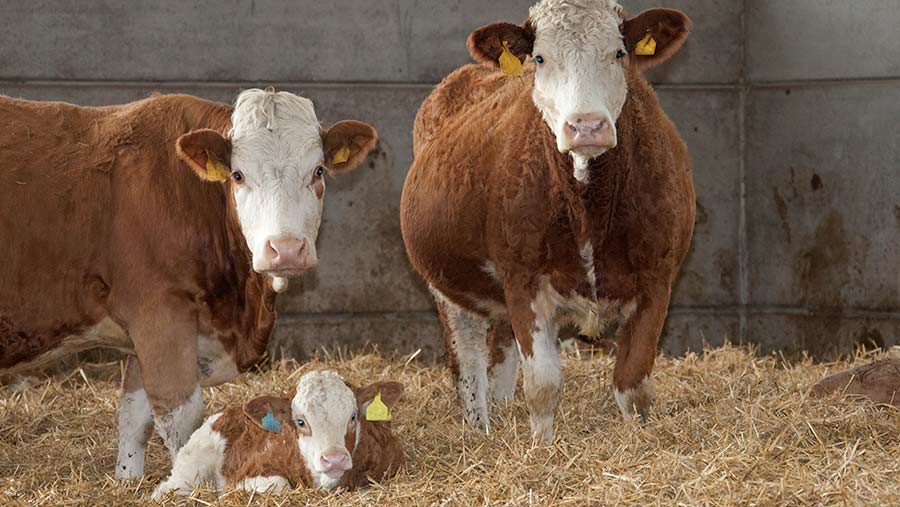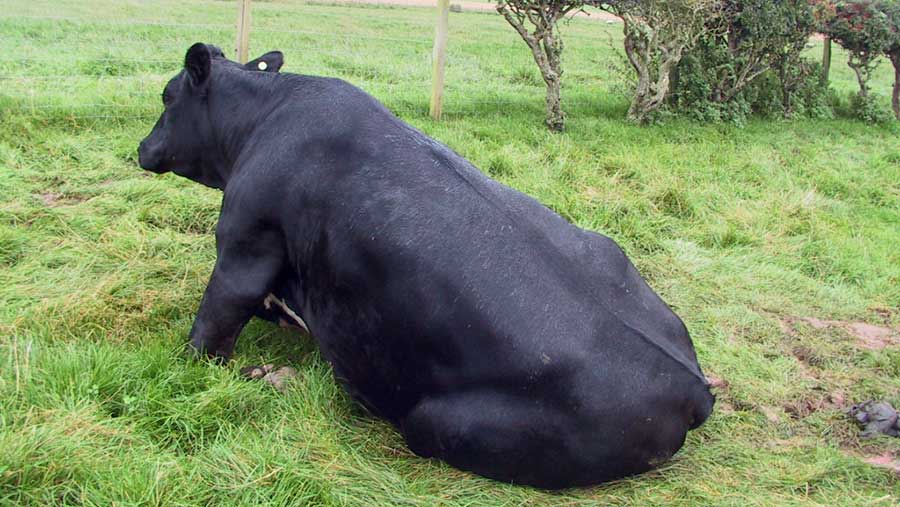How to prevent and treat common problems at calving
 © Tim Scrivener
© Tim Scrivener For suckler farmers, income for the year is dependent on a successful calf crop, so keeping cows as healthy as possible at calving time is critical to ensure each animal in the herd produces a healthy, strong calf.
Below, Charlie Neale, veterinary surgeon at Shepton Vets, Somerset, takes a look at some of the most common diseases and health issues in suckler cows around calving time and explains how to identify, prevent and treat each condition.
See also: Step-by-step practical guide to using AI in your spring-calving beef herd
Milk fever
What is it?
Milk fever – or hypocalcaemia – is an imbalance or a low level of calcium in the blood. It can be coupled with other deficiencies such as low magnesium and phosphorous.
Common causes
The majority of cases are due to incorrect nutrition. It is also more common in older cows.
Signs
- Downer cow and unable to get up
- Low feed intake
- Cold ear and nose
- An ‘S’ shaped bend in the neck
- Constipation and firm dung
- Delayed or slow calving

© NADIS
How to prevent it
Optimising nutrition in the lead-up to calving is essential. This should include limiting the amount of potassium in the ration and increasing the acidity and magnesium content.
It is also worth identifying high-risk cows – for example older and milkier animals – and keeping a close eye on them around calving, using calcium supplements if necessary.
How to treat it
Treatment can be in the form of intravenous or oral calcium. The dose is dependent on the individual animal, but sick cows should receive at least a 400ml bottle.
More information on milk fever is available on the NADIS website.
Retained placenta
What is it?
A retained placenta is when the placenta fails to detach itself from the inside of the uterus.
Common causes
Milk fever may predispose a cow to retained placenta. Cows are also more likely to suffer if they have had an assisted calving or caesarean.
Signs
Any amount of placenta hanging from the vulva
How to prevent it
The selection and use of easy calving bulls can help to reduce the need for assistance and therefore minimise the risk of a retained placenta. Ensuring the nutrition and ration is right in the lead-up to calving can also help.
How to treat it
The most important thing to do is to address any underlying issues that could increase the risk of retained placentas, as well as avoiding the onset of infection and trimming off any very long parts.
There are pessaries available on the market, but there is limited evidence on the effectiveness of this treatment.
Gentle traction can be performed at between three and five days post-calving, but this has to be carried out by a veterinary surgeon.
Abortion
What is it?
Abortion is when a calf is born – dead or alive – before 270 days of gestation.
Common causes
The majority of abortions are caused by infections such as Neospora and BVD. Stress can also increase the risk of abortion.
Signs
- Displaying signs of calving before the anticipated due date
- Returning to oestrus after being confirmed in calf
- Muck around the back end but no sign of a calving
How to prevent it
It is possible to vaccinate against some infectious diseases which can help to reduce the risk of abortion as a result of infection. However, for diseases such as Neospora, this comes down to management – for example, picking up after dogs.
How to treat it
Unfortunately, there is no treatment when abortion occurs. However, if a cow does abort, it is important to ensure the animal doesn’t become sick from secondary problems such as a retained placenta. A fertility check can be useful to ensure cows have cleansed properly following an abortion.
Uterine infections
What is it?
Uterine infections are the presence of unwanted bacteria – at a pathogenic level – in the uterus after calving. An example of this could be metritis which is caused by a bacterial infection and leads to inflammation of the uterus.
Common causes
Infections are often caused by a disturbance to the natural environment of the uterus at the time of calving. This can often be as a result of assisted calvings or abortions.
Signs
- Foul smelling discharge from the uterus
- Evidence of the cow straining
- Failure to start cycling again
- General unwellness in the animal
How to prevent it
Preventing uterine infections is all about managing the external environment and limiting exposure to predisposing factors.
How to treat it
In mild cases, the symptoms will often resolve themselves. When an animal is systematically unwell a course of antibiotics may be needed – typically penicillin.
Inducing cows to start cycling again can also help to rectify any issues, and in severe cases an iodine wash-out can be carried out, though this will have to be done by a vet.
Dystocia
What is it?
An abnormal or difficult calving at any stage of labour.
Common causes
Uterine torsions, milk fever, failure of birth canal to open, foetal abnormalities – such as Schmallenburg – and oversized calves are all factors that can contribute to a case of dystocia.
Signs
Cow struggling or failure to calf on or past the due date.
How to prevent it
Ensuring the bull isn’t going to obviously cause feto-maternal problems is really important, for example by not putting large continental breeds on small heifers.
Using estimated breeding values (EBVs) for areas such as calving ease can help to guide this decision.
The most important thing to do in terms of prevention is to monitor the actual calving and consider if what is happening is normal. For example, can you feel the two front feet? Is the nose there?
How to treat it
In most cases, assistance will be needed to help birth the calf. If you do need to intervene, it is essential to make sure you use a clean gloved arm, the vulva is clean and plenty of lubricant is used.
Top tips for dealing with dystocia
- The use of calving sensors can be really helpful to monitor the onset of calving.
- If two hours have passed since the first signs of calving, start checking the cow on a half-hourly basis.
- If you do have to intervene, check if the cervix is open – can you put a hand straight in?
- Are the two front legs and head within touching distance?
- Proceed with care and do not be afraid to call a vet if you’re unsure.
Mastitis
What is it?
Mastitis is an inflammation of the mammary gland, affecting one or multiple quarters.
Common causes
Exposure to bacteria through poor hygiene, contaminated bedding or poor housing. Infection can also occur if there is an injury to the udder or teat, creating an opportunity for bacteria to enter.
Signs
- Swollen, hot and/or hard quarter
- Large clots or pus present in the milk
- Fever
- Loss of appetite
- General unwellness
How to prevent it
Focus on general animal health and keep stock in a clean and dry environment to minimise exposure to bacteria.
How to treat it
Prompt identification and treatment are critical for minimising the effects of mastitis. This may mean using intermammary antibiotics and the infected quarter will need to be stripped out regularly.
In suckler herds, a good strong calf may be able to do the job itself, but it is important to monitor this in case manual assistance is required.
